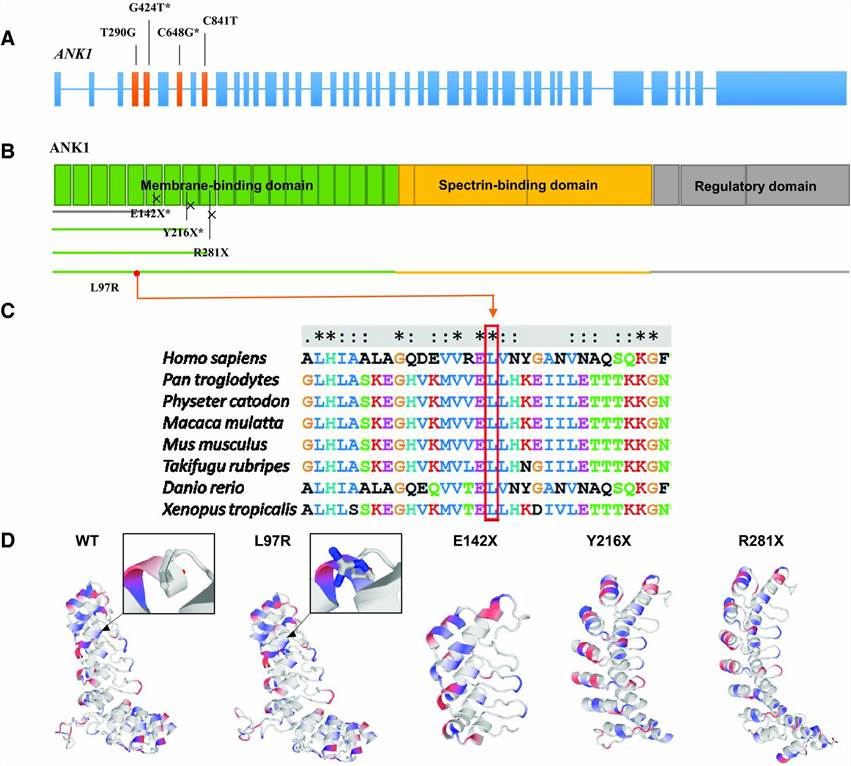ANK1 and Associated Diseases
As an expert in the field of gene therapy research, Creative Biolabs has accumulated extensive experience. We are willing to share professional background knowledge, such as the introduction of the Ankyrin 1 (ANK1) gene.
Background of ANK1
There are three members of the Ankyrin gene family: ANK1, ANK2, and ANK3. Ankyrins are a family of proteins closely related to the major junction between the spectrin-actin-based red blood cell membrane skeleton and the plasma membrane. Ankyrin deficiency is considered to be a major factor in hereditary spherocytosis (HS). Furthermore, ankyrins are involved in many activities such as cell motility, activation, proliferation, contact, and maintenance of specialized membrane domains. Most ankyrins contain three domains, each of which is critical to their functions. Different gene products and alternative splicing of the same gene products contribute to the isomeric diversity of ankyrins. ANK1, the prototype of this family, was first discovered in red blood cells but also has been found in the brain and muscles as well.
Introduction to ANK1
The ANK1 gene is located on chromosome 8p11.2 and is 160 kb in size. The ANK1 protein encoded by this gene contains 1880 amino acids with 3 domains. This protein is abundantly expressed mainly in red blood cells but is also found in muscle and brain cells. In red blood cells, ANK1 is located on the cell membrane, where it binds to other membrane proteins. Membrane proteins combine with each other to maintain the stability and structure of red blood cells. Notably, ANK1 also performs similar functions in muscle and brain cells.
 Fig.1 The pathogenicity of four ANK1 mutations predicted by bioinformatic analysis. (Hao, 2019)
Fig.1 The pathogenicity of four ANK1 mutations predicted by bioinformatic analysis. (Hao, 2019)
ANK1 and Associated Diseases
Variations in ANK1 may lead to abnormalities in erythrocyte surface membrane proteins. About half of HS patients are associated with abnormality of ANK1 protein. HS refers to a heterogeneous group of disorders characterized by the presence of spherocytes on peripheral blood smears. HS caused by ANK1 mutation is the most common type. The clinical features of these diseases are red blood cell deficiency, jaundice, and splenomegaly. Common complications include cholelithiasis, hemolytic episodes, and aplastic crisis. To date, more than 190 HS-related ANK1 mutations have been identified, including nonsense, missense, and splice mutations, small or large deletions, insertions, mutations, and complex rearrangements. Furthermore, although HS is not a neurological disorder, patients with HS caused by mutations in ANK1 are often accompanied by several neurological disorders, including cerebellar defects and spinal cord disorders.
Potential Mechanisms
The function of ANK1 in erythrocytes has been the focus of research since HS is one of the most common hemolytic anemias. In addition to ANK1 mutations, mutations in ANK1 binding partners are also associated with HS. These mutations may lead to reduced mechanical elasticity of the erythrocyte membrane, resulting in fragmentation of erythrocytes due to the high shear environment of the vasculature.
If you have any difficulties in your gene therapy project, please feel free to contact us for more information.
Reference
- Hao, L.; et al. Two novel ANK1 loss-of-function mutations in Chinese families with hereditary spherocytosis. The Lancet. 2019, 23(6): 4454-4463. Distributed under Open Access license CC BY 4.0, without modification.
